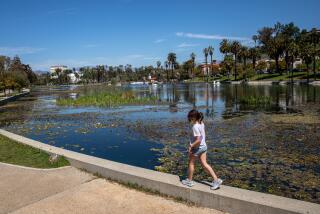Jury Orders Monsanto to Pay $16 Million in Tiny Dioxin Spill
BELLEVILLE, Ill. â A jury has determined that Monsanto Co. failed to warn a Missouri town about the risks of a 1979 spill containing less than a teaspoon of dioxin and ordered the giant chemical company to pay $16.2 million in punitive damages.
Monsanto said it would appeal Thursdayâs verdict, which concluded one of the nationâs longest jury trials--3 1/2 years of testimony and eight weeks of deliberations.
The finding of misconduct resulted also in compensatory damage awards of $14,500 each to a mother and son who owned land near the Sturgeon, Mo., spill site, and $1 each for the remaining 63 plaintiffs. The punitive damages were to be divided equally among all plaintiffs.
The lawsuit in St. Clair County Circuit Court accused St. Louis-based Monsanto in the Jan. 10, 1979, spill over a half-mile area. The rail shipment contained 19,000 gallons of raw material used in a wood preservative.
Headaches Asserted
The plaintiffs, contending that they suffered headaches and fatigue and feared genetic damage, had sought $100 million in punitive damages and $35.4 million in compensatory damages.
Monsanto argued that the amount of dioxin in the spill was too small to cause injury.
âWeâre just glad we won,â said Frances Kemner, who was awarded $14,500 for damages to her land alongside the tracks where the spill occurred. âItâs time Monsanto had something happen to them so theyâll know they canât do this over the whole country.â
Monsanto attorney David Snively said: âWeâre confident of overturning that award.â
Monsanto was also ordered to pay $81,000 in court costs for the trial, which began Feb. 22, 1984, and included testimony from 182 witnesses, 6,000 exhibits and more than 100,000 pages of transcripts.
Dioxin is known to cause brain, heart and genetic damage in laboratory animals. The health risk to humans is subject to debate, although the form of dioxin found in the soil at the spill site has been called the worldâs most toxic synthetic chemical.
More to Read
Inside the business of entertainment
The Wide Shot brings you news, analysis and insights on everything from streaming wars to production â and what it all means for the future.
You may occasionally receive promotional content from the Los Angeles Times.










